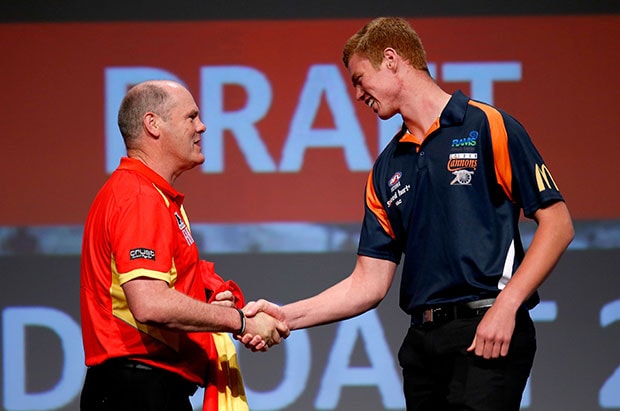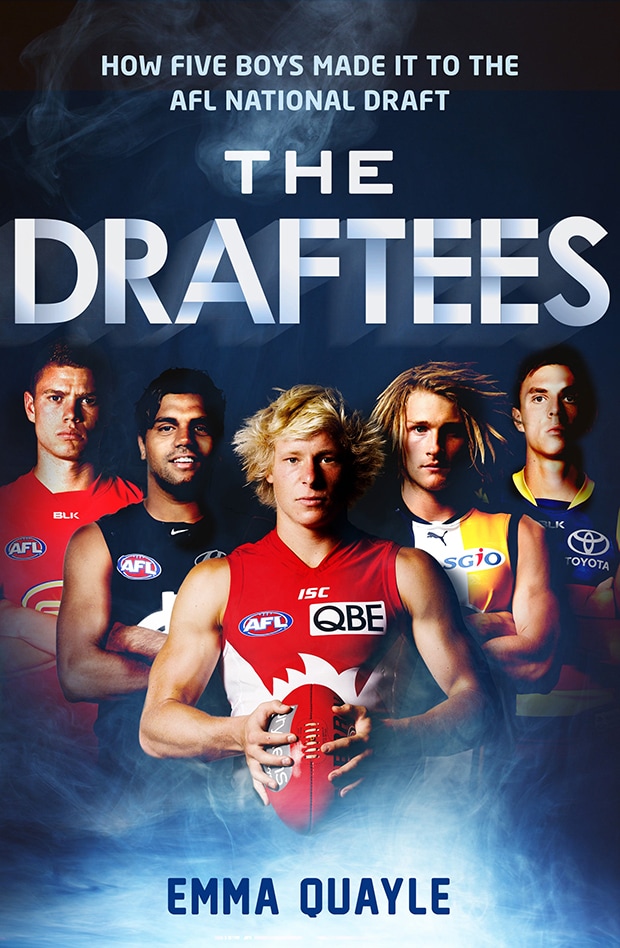The path travelled by underage talent to the national draft is an intriguing one, and one that is only known by those closest to the player. But through the eyes of award winning football journalist, and talent identification expert, Emma Quayle, the journey of five first-year AFL players is explored in great depth in her new book, The Draftees.
In her new book – the second time she has followed potential draftees prior to the draft - Quayle followed the lives of five players – Carlton’s Clem Smith, West Coast’s Tom Lamb, Adelaide’s Jake Lever, Sydney’s Isaac Heeney and Gold Coast’s Peter Wright – in their draft year.
The night these players had their names read out by an AFL club was the end of one journey, but the beginning of a new one. Quayle takes us through the process it has taken for each player to earn the opportunity to play at the highest level. All the triumphs, and all the tribulations are chronicled in The Draftees.

An extract from The Draftees on the night Peter Wright was selected by the Gold Coast SUNS with pick No. 8:
Pete had flown up to Queensland on Wednesday morning. Packing his bags in his bedroom, a strange thought had occurred to him: by the time he was back there on Friday afternoon, he would be on an AFL list. He had a media conference to do with Jarrod Pickett on Thursday morning, and then went to visit his nanna. His three grandparents had driven up on Monday, as had his dad and Serena, keen to squeeze in a theme park or two while they were there. By late on Monday his nanna wasn’t feeling well, and as of early Thursday afternoon she was stuck in hospital, feeling better but still on a drip, waiting to find out whether she had a blood clot and disappointed that she might not get to be there for the biggest night of his life.
The boys and their families were sitting around tables at the front of the convention centre. Pete took a moment to look up behind him, to the seats upstairs where he had been sitting twelve months earlier. For those few seconds, it felt like the year had flown by. He sat there for so long waiting for the draft to start that his nerves began to set- tle; he couldn’t know for sure that the Suns were going to choose him, but something inside him told him that’s what was going to happen. Then Ian Kyte wandered by, with some gossip. ‘There’s some talk that Collingwood or GWS might pick you,’ he said. ‘Are you serious?’ Pete asked, and Kyte was. That was when he started to feel more nervous than he had, in all of the days, weeks and months leading up. OK, he thought. Start. Just start. And then make it be over.
He didn’t have to wait too long. After St Kilda called McCartin’s name, Melbourne chose Petracca and Brayshaw at picks 2 and 3. GWS took Pickett at 4 and Collingwood chose Jordan De Goey at 5. The Giants then had their two picks in a row, 6 having come from the Bulldogs as part of the Tom Boyd–Ryan Griffen trade and 7 from Carlton for Kristian Jaksch. Could they? Would they? Pete had kept an eye on the TV cameramen all night. They had seemed to be in the right spot for every pick, and they weren’t anywhere near him. He was onto something: the Giants chose Caleb Marchbank with their first pick, then called Paul Ahern’s name with the second.
That left the Gold Coast. ‘Player 215404,’ said Dom Ambrogio. ‘Peter Wright. Calder Cannons, Moonee Valley Football Club.’
The Suns had rated Pete highly all year. But for most of the year they hadn’t considered him a player they were likely to have access to. Gold Coast had held a top-eight spot for the first half of the sea- son, and it was only through losing seven of the last ten games that they had landed a top 10 pick. Even then, there had been no cer- tainty that Pete would make it to them. Before the trade period began, the Lions and the Bulldogs had both held top-six picks. Both clubs were looking for a tall forward, and both had shown enough interest in Pete to make it highly possible that he would end up at either club. After trading was when things started to become clearer. It was obvious St Kilda wasn’t going to take him. Everyone knew Melbourne was going to go another way. That meant that while Pete had to get past four more picks to reach the Suns, he only had to be passed up by two clubs. ‘The stars aligned,’ said Scott Clayton, the Suns’ list manager. ‘If Dayne Beams doesn’t quit Collingwood and Ryan Griffen doesn’t quit the Bulldogs, we don’t end up with Peter Wright.’
There were a number of reasons Pete became their choice, ahead of Nakia Cockatoo and Liam Duggan. Tall forwards were extremely hard to find, and if the Suns’ team progressed as the club hoped and believed it would, they might not have access to a pick placed high enough to get one for some time. They were well stocked for talls, meaning they had time to let him develop. They wouldn’t have to rush him into the side, or sell him to supporters as some sort of for- ward-line saviour. They could also be a little bit tactical, knowing they held picks 15 and 29 and that smaller players were likely to be available at those picks: even picking Wright themselves pushed another midfielder one spot further down the order. Above all else, though, they really, really liked him. That he identified as a tall forward − and that he wanted to be a very good one − appealed to them. They thought he covered the ground incredibly well for a 203-centimetre player. That he always took front position in the ruck when sent in there − they went back through the tapes to watch every single one of his contests − told them he was up for the physi- cal challenge, despite preferring to play a different position. That he was willing to express that preference − to explain himself, to state his case − was something the recruiters liked, too.




